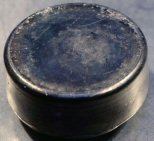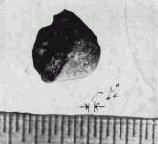 Discovery Information Discovery Information
|
| Who: G.T.Seaborg, J.W.Kennedy, E.M.McMillan, A.C.Wahl |
| When: 1940 |
| Where: United States |
|
 Name Origin Name Origin
|
| From planet Pluto. |
| "Plutonium" in different languages. |
|
 Sources Sources
|
| Almost all plutonium is manufactured synthetically, extremely tiny trace amounts are found naturally in uranium ores. Most plutonium is made synthetically by bombarding uranium with neutrons.
|
| Annual production is around 20 tons, it is thought that world reserves are around 500 tons. |
|
|
 Uses Uses
|
| Used in bombs and reactors. Complete detonation of plutonium will produce an explosion equivalent to 20 kilotons of Trinitrotoluene
(TNT) per kilogram (of plutonium).
|
|
 History History
|
| The production of plutonium and neptunium by bombarding uranium-238 with neutrons was predicted in 1940 by two teams working independently: Edwin M. McMillan and Philip Abelson at Berkeley Radiation Laboratory at the University of California, Berkeley and by Egon Bretscher and Norman Feather at the
Cavendish Laboratory at University of Cambridge. Coincidentally both teams proposed the same names to follow on from uranium,
like the sequence of the outer planets.
|
| Plutonium was first produced and isolated on February 23, 1941 by Dr. Glenn T. Seaborg, Dr. Michael Cefola, Edwin M. McMillan, J. W. Kennedy, and A. C. Wahl by deuteron bombardment of uranium in the 60-inch cyclotron at Berkeley. The discovery was kept secret due to the war. It was named after Pluto, having been
discovered directly after neptunium (which itself was one higher on the periodic table than uranium), by analogy to solar system planet order as Pluto was considered
to be a planet at the time (though technically it should have been "plutium", Seaborg said that he did not think it sounded
as good as "plutonium"). Seaborg chose the letters "Pu" as a joke, which passed without notice into the periodic table. Originally,
Seaborg and others thought about naming the element "ultinium" or "extremium" because they believed at the time that they
had found the last possible element on the periodic table.
|
| Chemists at the University of Chicago began to study the newly manufactured radioactive element. The George Herbert Jones
Laboratory at the university was the site where, for the first time, a trace quantity of this new element was isolated and
measured in September 1942. This procedure enabled chemists to determine the new element's atomic weight. Room 405 of the
building was named a National Historic Landmark in May 1967. During the Manhattan Project, the first production reactor was
built at the Oak Ridge, Tennessee site that later became Oak Ridge National Laboratory. Later, large reactors were set up
in Hanford, Washington, for the production of plutonium, which was used in the first atomic bomb used at the "Trinity" test
at White Sands, New Mexico in July 1945. Plutonium was also used in the "Fat Man" bomb dropped on Nagasaki, Japan in August
1945. The "Little Boy" bomb dropped on Hiroshima utilized uranium-235, not plutonium.
|
| During the initial years after the discovery of plutonium, when its biological and physical properties were very poorly understood,
a series of human radiation experiments were performed by the U.S. government and by private organizations acting on its behalf.
During and after the end of World War II, scientists working on the Manhattan Project and other nuclear weapons research projects
conducted studies of the effects of plutonium on laboratory animals and human subjects. In the case of human subjects, this
involved injecting solutions containing (typically) five micrograms of plutonium into hospital patients thought to be either
terminally ill, or to have a life expectancy of less than ten years either due to age or chronic disease condition. These
eighteen injections were made without the informed consent of those patients and were not done with the belief that the injections
would heal their conditions; rather, they were used to develop diagnostic tools for determining the uptake of plutonium in
the body for use in developing safety standards for people working with plutonium during the course of developing nuclear
weapons.
|
|
 Notes Notes
|
| The heat given off by alpha particle emission makes plutonium warm to the touch in reasonable quantities; larger amounts can boil water.
|
| All isotopes and compounds of plutonium are toxic and radioactive.
|
|
 Hazards Hazards
|
| Plutonium is radioactive. When taken in by mouth, plutonium is less poisonous (except for risk of causing cancer) than several
common substances including caffeine, acetaminophen, some vitamins, pseudoephedrine, and any number of plants and fungi. It
is perhaps somewhat more poisonous than pure ethanol (C2H5OH), but less so than tobacco; and many illegal drugs. From a purely chemical standpoint, it is about as poisonous as lead and other heavy metals.
|





 Discovery Information
Discovery Information
 Name Origin
Name Origin
 Sources
Sources
 Uses
Uses
 History
History
 Notes
Notes
 Hazards
Hazards
 Images
Images

